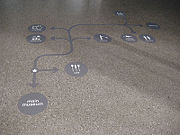Caitlin C Draft Two
From DigitalRhetoricCollaborative
Wayfinding
Wayfinding is the use of certain cues to navigate a physical or digital space. It is a termed coined by Kevin Lynch to describe environmental legibility, elements of an environment that allow successful navigation through complex spaces. [1] Originally used as a technique for navigating physical environments, it has become applicable in navigation of digital environments and web design.
Contents |
History
Wayfinding did not develop until the early 20th century. The term was coined by Kevin Lynch in The Image of the City in which he recognized the importance of an environmental image in wayfinding tasks.[2] He divided the elements of a city into five distinct groups: paths (streets, bus lines, etc), edges (physical barriers such as walls or rivers), districts (places with distinct identities such as Wall Street or the Empire State Building), nodes (major intersections or meeting places), and landmarks (visible structure that can be used to assess orientation over long distances).[3] Archietexts, urban planners, landscape architects, environmental graphic designers, and behavioral and cognitive psychologists have contributed to the study of wayfinding.[4]
Modern Physical Usage
Today, the wayfinding technique is most commonly used in large buildings like hospitals and airports. Signs and architecture are intricately designed with the user in mind. Wayfinding airport designer Jim Harding asserts, "Ultimately, if we do our job well, wayfinding enhances the customer experience without them knowing why or how." [5] Every aspect of design is considered from signage, lighting, and color to general architecture of the space. It involves plotting predictable paths and decision points in the signage, so users can easily find their way around in unfamiliar territory.
Signage
The Arrow
The arrow is a tool in signage that helps to control movement and maintain stability. The person becomes a traveler guided directly by specific procedures for movement. The arrow essentially transforms information in a certain order. When the space is planned in the way a map is planned, the signs are less about representation and more about movement. The arrow, specifically, is a tool for guiding movement and behavior in an unfamiliar space. [6]
Modern Digital Usage
Navigation and Usability
References
- ↑ Webstyle Guide to Navigation
- ↑ International Digital Media and Arts Association on Wayfinding
- ↑ Webstyle Guide to Navigation
- ↑ International Digital Media and Arts Association on Wayfinding
- ↑ The Atlantic: How You Know Where You're Going When You're in an Airport
- ↑ Fuller, Gillian. "The Arrow--Directional Semiotics: Wayfinding In Transit." Social Semiotics 12.3 (2002): 231. Academic Search Complete. Web. 12 Apr. 2015.


